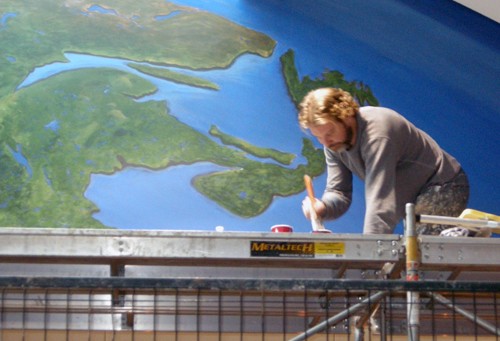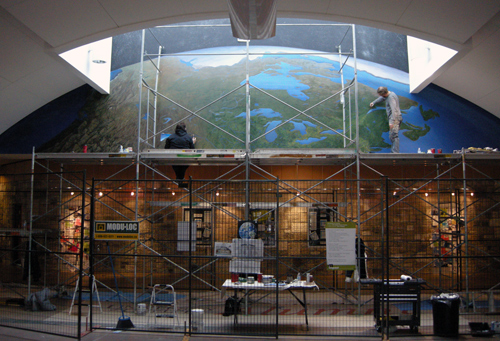
Scaffolding built 25 feet above the floor. A curved wall lit by sunshine streaming through the skylight. An artist kneeling on the scaffolding boards as he touches up the starry sky he’s painting.
No, it’s not Michelangelo and the Sistine Chapel. The result, though ─ a mural painting of Canada, all green and blue with the deeper blue ocean on both sides and the stars in a dark sky above ─ is definitely impressive. This giant mural is part one of a donor wall being created in Rozanski Hall.
Wendy Turner, senior development manager for stewardship and donor relations, began developing this concept in May 2010, meeting with Rick Murphy and others at d3 Impact. “We were looking for a way to recognize donors who contribute to The BetterPlanet Project,” she explains. “What we’ve come up with here is unique in two ways: first, we’ve never had a donor wall that ran consecutively with a campaign. Secondly, donor walls usually just have the person or company’s name. This one will have photos of the donor or of something that represents the donation, information about their gift and testimonials about why they have given their support to U of G.”
Rozanski Hall was chosen as the location, she adds, because it’s a central campus location and a place where students from many programs, as well as visitors, will walk through. The large open hall also provides space for a dramatic installation.
 Murphy says one of his goals was “to be sensitive to the architect’s vision for this building and to complement what already exists.” The final installation will have the painting of Canada as part of the planet, supported by four pillars, one for each of the four components of The BetterPlanet Project. (The components are food, environment, health and community.)
Murphy says one of his goals was “to be sensitive to the architect’s vision for this building and to complement what already exists.” The final installation will have the painting of Canada as part of the planet, supported by four pillars, one for each of the four components of The BetterPlanet Project. (The components are food, environment, health and community.)
Launched in September, the fundraising campaign aims to raise $200 million to help U of G increase its capacity for research that contributes to a better planet and to ensure that Guelph students have access to the latest discoveries in their field.
Referring to the donor wall, Murphy says: “We’ll have both fixed elements and elements that will change over time as more donors are added. In the beginning, it will feature not just donors but information about the campaign and the projects involved.”
This way, Turner explains, the wall also serves an educational purpose: letting people know about the issues and needs addressed by The BetterPlanet Project. With the mural completed, the pillars and information panels will be installed during the next few weeks. Turner plans to invite the donors being recognized to a special launch event in February or March.
Four artists were involved in painting the mural in December, but the process actually began a month earlier as the artists created the initial picture, using images from space as a guide; picture was then transferred painstakingly by hand onto the wall in Rozanski Hall.
“The hardest part is doing the work 20 feet up in the air,” says Murphy. “You have to keep getting down and walking back to see how it looks, then climb back up to keep painting.” Another challenge is that the mural is lit primarily by the skylight above it. Murphy explains that the painting crew had to get up early in order to be there when the sun came up; once the sun headed towards the horizon, the painting stopped.
Although the mural itself is actually flat, it gives the impression of being a curved surface, and the careful use of light and shadow makes the mountains and hills look as though they actually jut out from the wall.
Turner adds: “Seeing the original artist’s rendering is one thing, seeing the actual mural is breathtaking. It will be an amazing tribute to our donors, and I think they will be inspired by it. Donor walls are intended not only to recognize the support provided by people who have contributed, but also to motivate others to donate. I think this wall will achieve that.”